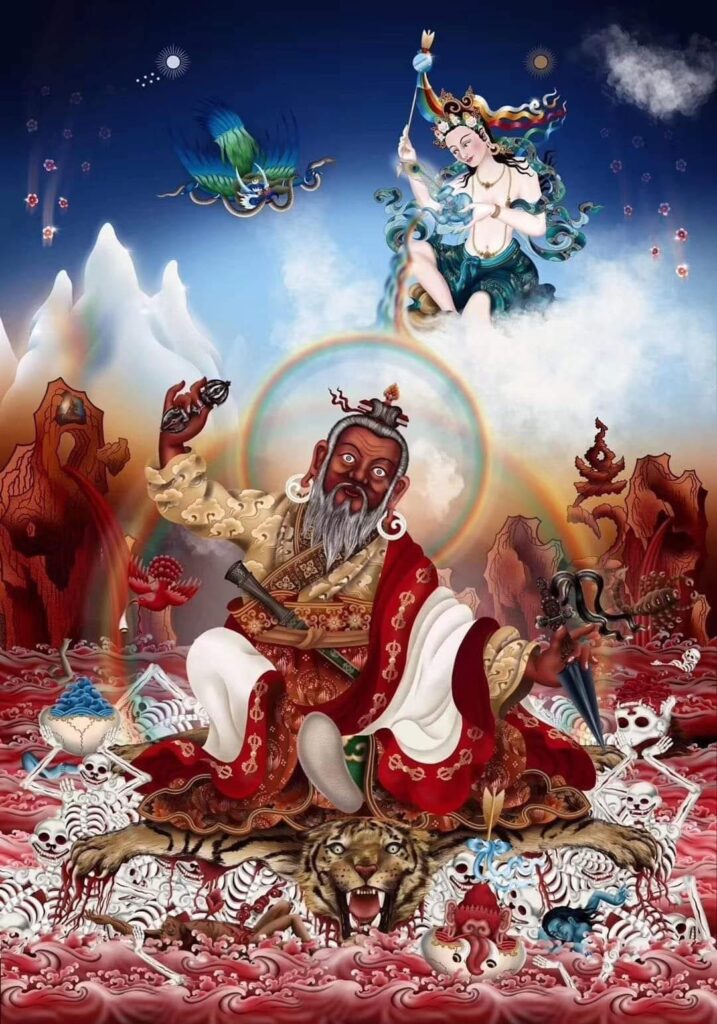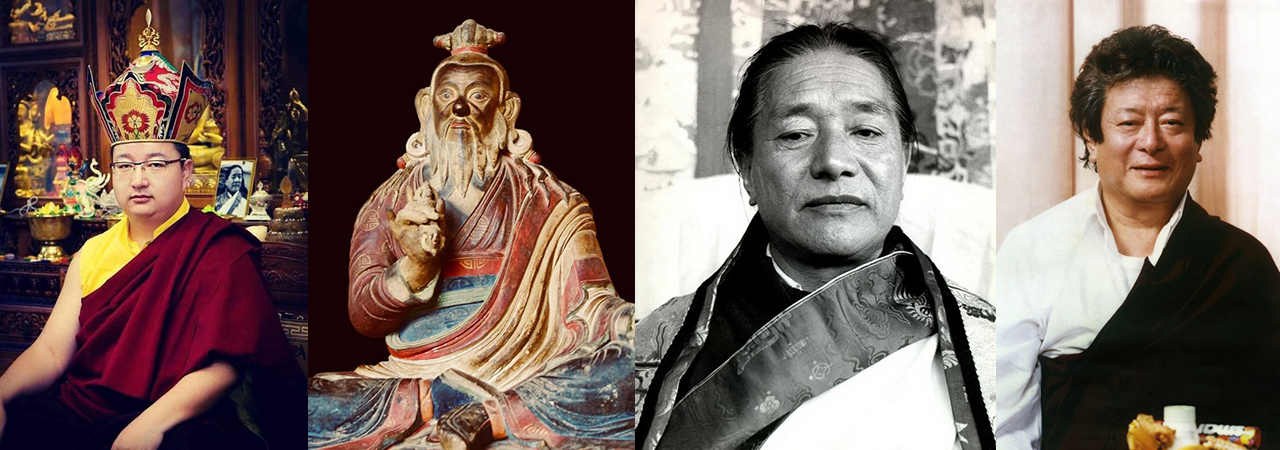
Dudjom Tersar is a New Treasure Lineage, meaning that it is a newer Buddhist tantric lineage. It is a very appropriate spiritual path during this difficult time in history, as foretold by Guru Padmasambhava. Dudjom Tersar is unique in that it is a complete tantric path to enlightenment available to householder practitioners. The word Dudjom itself means “demon defeater”. Tersar means “new treasure”. Compassion and wisdom are the basis of this profound lineage. Of course, the real demons are the demons of our own mistaken views.
The powerful Tibetan mystic, Dudjom Lingpa (1835-1904), is considered the founder of Dudjom Tersar. Dudjom Lingpa is unique in that he is a highly regarded teacher and tertӧn with no formal monastic training. Dudjom Lingpa had a large family and lived in poverty, yet through devotion and unwavering practice, he experienced direct encounters wisdom deities. The history of transmission of the Dudjom Tersar originates with Samantabhadra Buddha and was transmitted from Vajrasattva to Garab Dorje to Manjusrimitra to Sri Singha to Padmasambhava and Yeshe Tsogyal. Dudjom Lingpa revealed hidden teachings from Padmasambhava and Yeshe Tsogyal that total 21 volumes and over 20,000 pages of scripture, which form the foundation of the Dudjom Tersar. Through the famous practice of Dzogchen, multiple students of Dudjom Lingpa attained rainbow body and enlightenment. Presently, Dzogchen practice is considered the core, essential aspect of the Dudjom lineage- considered the innermost and highest path of the Vajrayana tradition. Pith instructions include Sangtri Kagyama, Neluk Rangjung, Magom Sangye, or the Nang Jang and Sherik Dorje Nonpo Gyu. These texts are Dzongchen tantra treasure texts revealed by Dudjom Lingpa himself as he experienced Kuntuzangpo directly in a vision. Many great masters across multiple Vajrayana traditions have validated these texts, particularly Jamgon Mipham Rinpoche, a well known master who is considered Manjushri in human form.
Dudjom Rinpoche Jigdral Yeshe Dorje (1904-1987), born in southeast Tibet, is the incarnation of Dudjom Lingpa. He received the Dudjom Tersar transmission from Dudjom Lingpa’s heart son (closest student), Gyurme Ngedon Wangpo. Dudjom Rinpoche famously spread the Dudjom Tersar across the world, as he lived through the Tibetan Diaspora. Those who crossed his path described him as penetratingly clairvoyant, graceful, and dignified. Dudjom Rinpoche was diligently trained in the teachings and practices of Buddhism from a young age. Similar to Dudjom Lingpa, Dudjom Rinpoche had direct communication with wisdom deities. He comprised 25 volumes of writings and revealed treasure teachings and also revised the entire Nyingma canon (kama). Dudjom Rinpoche taught around the world, but spent much of his later years with his family in Dordogne, France.
His Holiness Dudjom Rinpoche III Sangye Pema Shepa (1990-Present), often referred to as Dudjom Yangsi Rinpoche, is the third and most recent incarnation of Dudjom Lingpa. He was born in northeastern Tibet and recognized by many accomplished masters, including HH Chatral Rinpoche and HH Thinley Norbu Rinpoche. As a child, Rinpoche was famous for his noble and unwavering composure while sitting for hours on the throne. Dudjom Yangsi Rinpoche currently resides and teaches in Tibet. Before covid-19, he spent time giving teachings and empowerments across the world. Dudjom Yangsi Rinpoche received transmission and worked closely alongside HH Chatral Rinpoche throughout his youth, until Chatral Rinpoche’s parinirvana in 2015. Khenpo Ogen first saw Dudjom Yangsi Rinpoche while he was being enthroned at the young age of four at Chatral Rinpoche’s retreat center. Khenpo Ogen was a recipient of Dudjom Yangsi Rinpoche’s first ever Dudjom lineage empowerment in Pharping, Nepal after the completion of his three year retreat in Gangri Thakar, Tibet. His Holiness Dudjom Rinpoche III also bestowed Khenpo Ogen his Khenpo title in the Dudjom lineage in 2014. Khenpo Ogen is therefore under Dudjom Rinpoche’s guidance as a Dudjom lineage holder.
His Holiness Thinley Norbu Rinpoche (1931-2011) was born in Lhasa, Tibet, and is the eldest son of HH Dudjom Rinpoche. He was the incarnation of Tulku Drime Oser, who was a son of Dudjom Lingpa. He was also an emanation of Longchenpa, a legendary scholar and practitioner within Nyingma Buddhism. Before the invasion of Tibet, HH Thinley Norbu Rinpoche studied at the infamous Mindrolling Monastery. Similar to HH Dudjom Rinpoche, HH Thinley Norbu Rinpoche had a family and travelled the world spreading Dharma, eventually settling in the United States. HH Thinley Norbu Rinpoche wrote several pivotal works. Many Dharma practitioners were drawn to HH Thinley Norbu Rinpoche, as his presence emanated profound peace and realization, giving rise to devotion within his students. Khenpo Ogen considers Thinley Norbu Rinpoche to have “emanated profound peace and realization, giving rise to devotion within his students.” Khenpo Ogen first encountered Thinley Norbu Rinpoche in 1992 when he was frequently visiting his residence, Japarti, in Nepal. Khenpo Ogen was very young, but clearly remembers this first teaching with Thinley Norbu Rinpoche, as it had a profound impact him. Since these visits in Khenpo’s youth, he received many important teachings on Dzogchen and the Nyingthik tradition, Dudjom tersar empowerments and transmissions, until Thinley Norbu Rinpoche’s parinirvana in 2011. Khenpo Ogen considers himself bound with a unique and special lifetime devotional connection towards Thinley Norbu Rinpoche. Khenpo Ogen states, “In his presence, I felt like a son who can’t walk being cared for by a loving father. I felt blessed by his warm presence and heart teachings. I’m very fortunate to have His Holiness (Thinley Norbu Rinpoche) as my root teacher in this life. I feel his blessings in the core of my being and in my practice, so deeply that I don’t need anymore guidance on this path. His speech had a quality that entered right into your heart, immediately, to whoever heard. And his teaching for pith instructions are no other than Garab Dorje’s speech, the Kuntuzangpo in human flesh.”

